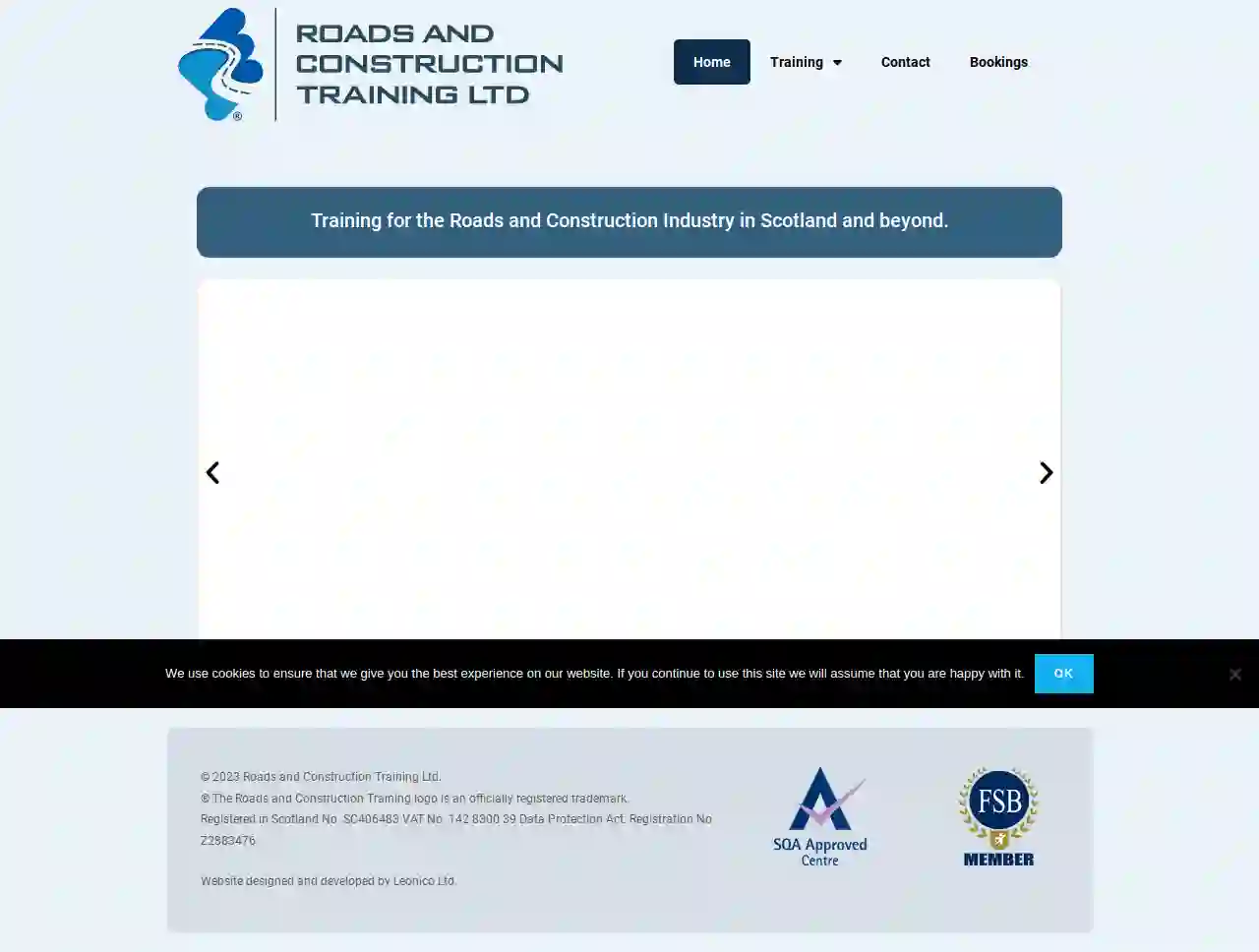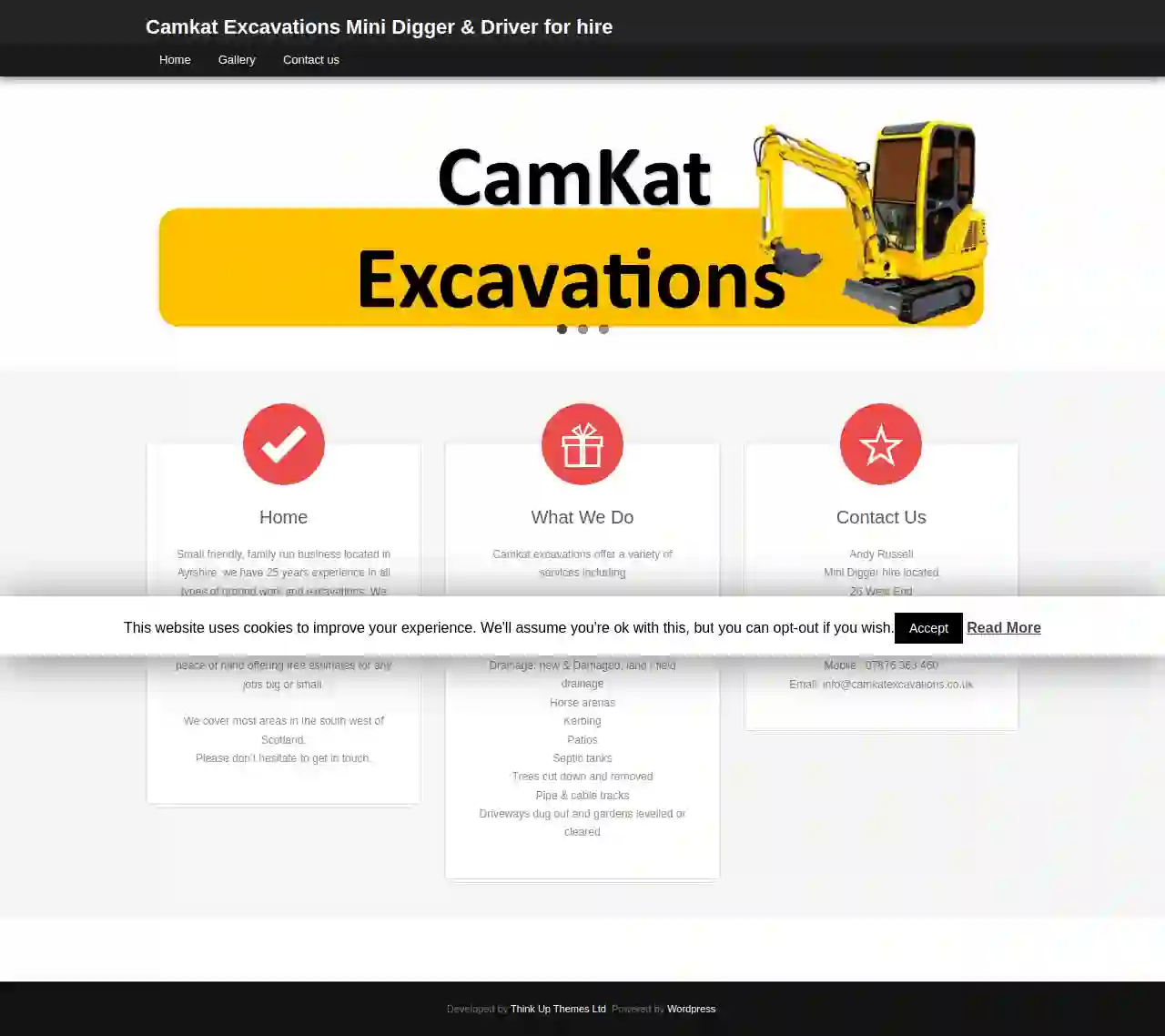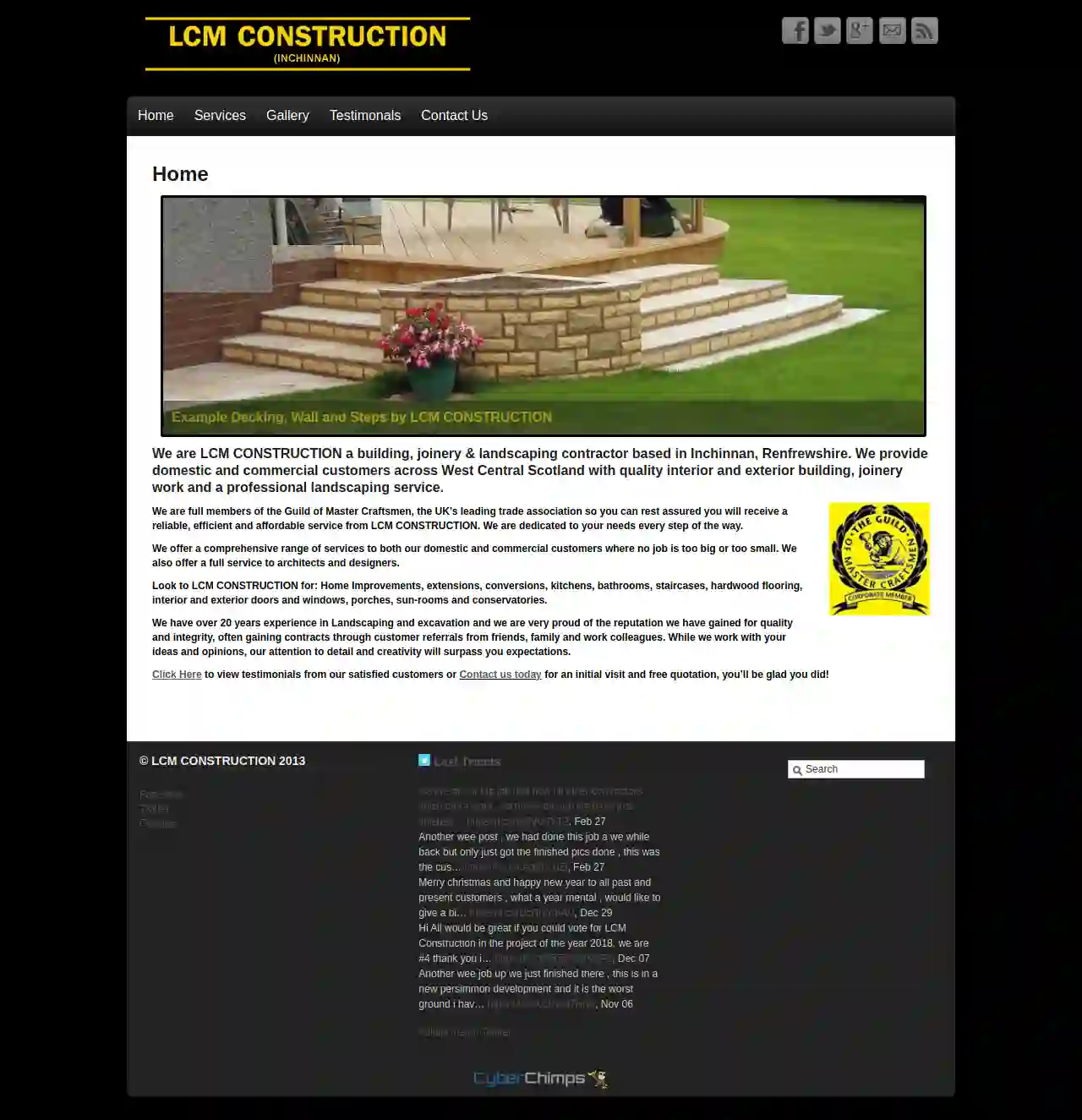Excavation Contractors Beith
Top Excavating Contractors in Beith
Get 3 FREE Excavation Contractors quotes for your project today! Compare profiles, reviews, accreditations, portfolio, etc... and choose the best service.

Roads and Construction Training Ltd
Glasgow, GBTraining for the Roads and Construction Industry in Scotland and beyond. Roads and Construction Training are a professionally run training organisation whose instructors are all experts within their own fields of operations, roadwork’s, construction and utilities sectors. Having been approved by the Awarding body SQA, we can provide an extensive range of highly recognised awards, all of which comply with The Government Legislative requirements of HSE and SQA, and The National Occupational Standards, also that of The National Specification Requirements for NRSWA and Codes of Practice associated within Roadwork’s Specifications for working on Roads, Highways.We are about “Taking the Training to the Client, not the Client to the Training”. On-Site Training and AssessmentEquipped to provide On-site training and assessment where required, our highly experienced and qualified staff are committed to providing a quality service where ever the need maybe. Nowadays within the Roads, Construction and Utilities Industries there has never been a greater demand for the Improvement of Standards and Quality of Workmanship to improve. Our highly recognised qualifications awarded and approved by SQA, are for all occupations within these Industries mentioned above, and are aimed at all levels from the most junior to the most senior these qualifications are for youth and adult learning, they are highly recognised for improving personnel skills, employability and career prospects and are about improving and putting the skills back into the industry. Our service shall meet the standards with a view to improving them and to ensure we are achieving the highest level of satisfaction for our clients.
- Services
- Why Us?
- Accreditations
- Gallery
Get Quote
ECOTECH
Office 1 Cameron House 17 Glasgow Road, Hardgate, Clydebank, Scotland, G81 5PJ, GBRENEWABLE ENERGY IN SCOTLAND Contact our electricians at Ecotech Contracts Ltd. We serve Glasgow and across the UK and Republic of Ireland. OVER 50 YEARS' EXPERIENCE Ecotech Contracts Ltd is a Scotland based solar energy company dealing with commercial clients across Scotland. With the cost of energy rising at an unimaginable pace, it is the aim of Ecotech Contracts Ltd to help large businesses take control of these cost increases using the huge potential for energy generation found within solar technology. SOLAR FOR THE HOME At Ecotech Contracts Ltd in West Dunbartonshire, we can help you towards making major savings on your energy bills by installing solar panels for your home. Excess energy can either be stored by you or sold to the grid. WIND TURBINES Our highly skilled team has installed over 10 wind and solar farms across the UK. A wind turbine can produce an enormous amount of green energy for your business and is a fantastic signpost that your business is committed to sustainability. EV CHARGING With the rising cost of petrol, and more investment in the EV industry, it’s no wonder that EVs are becoming increasingly popular. Charging an EV can take as little as 30 minutes. DOMESTIC RETROFIT WORK We provide whole house retrofit assessments, to assess all required energy efficiency measures to ensure properties are progressing towards the 2050 net zero target in line with PAS 2035 standards. COMMERCIAL SOLAR Solar panels can be an excellent return on investment and increase your eco-credentials, and they can recoup their installation costs in a few years. How ecologically friendly your business is will increasingly influence potential customers. BATTERY STORAGE It is possible to sell any excess energy to the grid, however more and more people are opting to invest in battery storage so they can use all the energy they produce. ELECTRICAL CONTRACTING We have many years’ experience across all sectors of industry. For all kinds of domestic, industrial, and commercial electrical projects we exceed expectations and provide an excellent service. Our Project Managers will ensure the work is completed safely and efficiently. PPA Ecotech Contracts Ltd are a developer and work in partnership with an investor in renewable energy projects across many markets including the UK. As part of this, we offer a range of energy supply options, which have the potential to reduce customers' energy costs whilst offering 100% renewable energy supply.
- Services
- Why Us?
- Our Team
- Gallery
Get Quote
Drain Fix Solutions
4.961 reviewsGlasgow, GBAbout Us We are a locally owned business covering Glasgow and the West with over 8 years experience in the drainage industry. All our staff are fully trained and qualified so you know you are in the best hands when it comes to your drainage issues. We have probably dealt with every drainage problem imaginable so there’s not an issue too small or big. Our phone lines are operational 24/7 so you can call us anytime to book in your appointment. We specialise in all aspects of Domestic and Commercial Drainage issues and aim to carry out the works as quickly and efficiently as possible meaning less disruption for our customers. We offer a mix of fixed pricing and job rates for our services and all works are explained to you prior to commencement to ensure you are aware of what the job entails and the cost before starting. Please click on one of our services to find out more.
- Services
- Why Us?
- Testimonials
- Gallery
Get Quote
Concrete Repairs Ltd (CRL)
4.68 reviewsPortland House Britannia Road Chesterfield, Chesterfield, S40 2TZ, GBWelcome to CRL CRL is one of the leading specialist concrete repair & asset maintenance contractors for buildings and structures operating across the UK through a network of 6 regional offices. We provide a comprehensive asset management and asset maintenance service for buildings and all concrete structures. With over 65 years' experience, CRL deliver proven and cost effective refurbishment options which meet our clients' objectives of upgrading and extending the life of their structures. CRL are flexible and work collaboratively with our clients. This has helped us secure a high percentage of repeat business across all sectors as either a Principal Contractor or specialist sub-contractor. Safety & Sustainability CRL have a reputation based on quality and innovative engineering underpinned by our commitment to health, safety and sustainability. CRL are committed to reducing our carbon footprint and that of our Clients' by conducting our business and the works we carry out in accordance with the guidelines set out in the ICE's Carbon Project initiative. As a company we operate knowing that nothing we do is so important that it cannot be done safely and sustainably. We strive to create a safe, healthy and sustainable environment in which no one, including our planet, is harmed.
- Services
- Why Us?
- Our Team
- Gallery
Get Quote
Blocked Drain Glasgow
549 reviews2nd Floor, Clyde Offices, 48 West George Street, Glasgow., Glasgow, G2 1BP, GBBlocked Drain Glasgow: Your Trusted Drainage Experts in Glasgow Blocked Drain Glasgow is a well-established drainage company based in Glasgow, offering a comprehensive range of services to both domestic and commercial clients. We are committed to providing quick, efficient, and reliable solutions for all your drainage needs. Our team of experienced and highly trained drainage engineers are equipped with the latest high-pressure jetting equipment to tackle even the toughest blockages. We specialize in: • Unblocking drains • Drain clearance • CCTV camera work • Sewerage clearance • Septic tank emptying • Drain testing and installation • Drain repairs and maintenance • Drain excavation • Drainage consultancy • General plumbing work We understand that drainage problems can be stressful and disruptive, which is why we offer a 24-hour emergency callout service. We are here to help you around the clock, ensuring your peace of mind. At Blocked Drain Glasgow, we pride ourselves on our commitment to quality and customer satisfaction. All our work is guaranteed, and we are dedicated to providing a professional and friendly service. Contact us today to discuss your drainage requirements and receive a free, no-obligation quote.
- Services
- Why Us?
- Testimonials
- Gallery
Get Quote
Affordable Drainage Solutions (Drain Unblocking / Cleaning)
584 reviews134 Clark Drive, Irvine, KA12 0NU, GBAbout Us Affordable Drainage Solutions is an independent company based on the West Coast of Scotland, we are passionate about solving drainage problems Blocked Drians Repairs etc and providing great customer experiences. ADS is run by Kevin Muir, the man behind ADS. Kevin looks forward to solving your drainage problems. Why choose Affordable Drainage Solutions? We have an expert team with over 25+ years of experience, we provide a professional Drain Unblocking, Blocked Drain Cleaning service at a competitive price. Contact us for a quote. Do you cover drainage emergencies? Our drainage engineers are available 24/7, 365 days a year. Be it a blocked drain,Cctv Surveys, domestic drain cleaning, cistern flooding etc. We are ready to take the stress out of your emergency. What locations does Affordable Drainage Solutions cover? We operate solutions to all drainage problems through Ayrshire, Renfrewshire, Glasgow South Side. Affordable Drainage Solutions Ayrshire locations (North Ayrshire, South Ayrshire & East Ayrshire)Including Irvine, kilwinning, Ardrossan, Saltcoats, Stevenston, West Kilbride, Ayr, Prestwick, Troon, Mauchline Cumnock, Kilmarnock,Stewarton,Kilbirnie,Dalry,Beith,Fairlie; Largs, Kilwinning and more. Affordable Drainage Solutions Renfrewshire LocationsJohnstone, Paisley, Bridge of Weir, Linwood, Bishopton,Kilmacolm,Howwood and more. Affordable Drainage Solutions Glasgow Southside LocationsPollockshaws, Giffnock, Newton Mearns, Dumbreck, Clarkston, Darnley and more.
- Services
- Why Us?
- Our Team
- Gallery
Get Quote
Camkat Excavations Ayrshire Mini Digger & Driver for hire
26 West End, Dalry, KA24 5DU, GBCamkat Excavations: Your Trusted Partner for Groundwork and Excavations in Ayrshire Camkat Excavations is a small, friendly, and family-run business with over 25 years of experience in all types of groundwork and excavations. We are based in Ayrshire and are dedicated to providing high-quality services to our clients. We understand the importance of a reliable and professional service, and we strive to exceed your expectations on every project. We are fully insured for your peace of mind and offer free estimates for any job, big or small. We cover most areas in the south west of Scotland. Our team is equipped with a 1.5 tonne excavator that is only 1m wide, making it ideal for tight spaces. We also have larger equipment available for bigger jobs. We are committed to providing a professional and efficient service, and we are always happy to answer any questions you may have. Please don't hesitate to get in touch.
- Services
- Why Us?
- Gallery
Get Quote
Rico Contracts
Unit 48, Greenhill Business Centre, Coatbridge, ML5 2AG, GBAbout Rico Contracts Ltd. Rico Contracts Ltd. is a closely knit group of experts, each specializing in their own field, who work together to form a formidable team. We are dedicated to providing the best possible service to our clients, ensuring that all maintenance needs are met, from a loose door handle to a complete overhaul of the surrounding grounds. We offer a variety of services at a reasonable cost, combining multiple resources and effective management for each job. Our commitment to health and safety is paramount, and we are proud to have an unblemished safety record. We operate with complete transparency, ensuring that everyone we work with can be assured of our high standards and tireless efforts to control any risk. We are also committed to environmental responsibility, operating a digital paperless system in the office and using biodegradable products wherever possible. We believe that we all have a moral duty to take care of our surroundings and take it seriously. Our priority is to conduct our business as cleanly and safely as we can while providing the best service possible to our clients. We are dynamic and dedicated to providing the best service possible to our clients. As we expand, we remain committed to our core values of quality, safety, and environmental responsibility.
- Services
- Why Us?
- Testimonials
- Gallery
Get Quote
Util-Serve Ltd
58 reviewsGlasgow, GBBased In Glasgow and supplying the surrounding areas... Here at Util-Serve Ltd we are your local experts for any and all drainage related services. Using the latest tools and equipment that the industry can offer, we can provide you with one of the most efficient services in the local region. Choosing to work with Util-Serve Ltd means that you will be working with one of the very best teams in the industry. All of our engineers have been trained and qualified from the industry-leading training provider, giving them in-depth and expert knowledge. Free no obligation quotations We want to help give you a clear picture of our services. Talking to one of our professionals we can provide you with a free no-obligation quotation, going into detail about the job and showing you what needs to be done. They will then provide you with a quotation to allow you to make an informed decision before you agree to go ahead with the project. OUR CUSTOMER REVIEWS At Util-Serve Ltd our main focus is providing our customers with the very best service possible, always looking for ways to adapt and fit your needs. Through this constant effort and development of our service we have gained a reputation for our quality of work and customer care. Take a look at our reviews from Yell.com to see what some of our existing customers have had to say
- Services
- Why Us?
- Gallery
Get Quote
LCM Construction
51 reviewsUnit 1, Inchinnan Business Park, Renfrewshire, Inchinnan, PA4 9SF, GBLCM CONSTRUCTION: Your Trusted Building, Joinery & Landscaping Experts LCM CONSTRUCTION is a reputable building, joinery, and landscaping contractor based in Inchinnan, Renfrewshire. We cater to both domestic and commercial clients across West Central Scotland, delivering high-quality interior and exterior building, joinery work, and professional landscaping services. As full members of the Guild of Master Craftsmen, the UK's leading trade association, we guarantee reliable, efficient, and affordable services. Our commitment to your satisfaction is unwavering, guiding us every step of the way. We offer a comprehensive range of services, handling projects of all sizes. Whether you need home improvements, extensions, conversions, kitchens, bathrooms, staircases, hardwood flooring, interior and exterior doors and windows, porches, sun-rooms, or conservatories, we've got you covered. We also extend our expertise to architects and designers, providing a full service to meet their needs. With over 20 years of experience in landscaping and excavation, we've built a strong reputation for quality and integrity. Our dedication to excellence often leads to new contracts through referrals from satisfied customers, friends, family, and colleagues. We work closely with your ideas and opinions, but our attention to detail and creativity will exceed your expectations. Explore our testimonials to hear firsthand from our satisfied customers. Contact us today for an initial visit and a free quotation. You won't regret it!
- Services
- Why Us?
- Gallery
Get Quote
Over 13,059+ Excavation Pros on our directory
Our excavation contractors operate in Beith & beyond!
ExcavationHQ has curated and vetted the Best Excavation Businesses near Beith. Find a top & reliable business today.
Frequently Asked Questions About Excavation Contractors
- Mechanical Excavation: Utilizing heavy equipment like excavators, backhoes, bulldozers, and loaders, suitable for most projects.
- Hand Excavation: Using hand tools (shovels, picks) for smaller excavations or delicate work near utilities.
- Blasting: Employing explosives to break up rock or hard materials, typically for large-scale projects.
- Hydro Excavation: Using high-pressure water jets to loosen and remove soil, often used for locating utilities or delicate excavation.
- Vacuum Excavation: Employing a vacuum system to suck up excavated material, suitable for safe excavation near utilities or in confined spaces.
- Utility Locates: Contact your utility companies to mark the locations of underground lines before excavation begins. This is usually a free service.
- Hand Digging: Excavate carefully by hand near marked utility lines to avoid damage.
- Potholing: Digging small test holes to expose and verify utility depths and locations.
- Safe Distances: Maintaining a safe distance between excavation equipment and marked utility lines.
- Vacuum Excavation: Using vacuum excavation techniques to expose utilities without digging, reducing the risk of damage.
- Trench Collapses: Unstable trench walls can cave in, posing a severe risk to workers. Proper shoring and sloping are crucial safety measures.
- Utility Damage: Striking underground utilities (gas, water, electric) can cause leaks, explosions, or electrocution. Accurate utility locates and careful digging are essential.
- Falling Objects: Materials or equipment falling into excavations can injure workers. Securing work areas and using appropriate safety gear is vital.
- Equipment Accidents: Operating heavy machinery involves risks of rollovers, collisions, or mechanical failures. Trained operators and proper equipment maintenance are critical.
- Environmental Hazards: Excavated soil might contain hazardous materials (asbestos, lead). Proper testing and disposal procedures are necessary.
- Clearly Define the Scope: Outline the project's goals, including the excavation area, depth, grade, and intended use.
- Obtain Necessary Permits: Research and acquire any required permits from your local authorities.
- Mark Utility Lines: Contact your utility companies to locate and mark underground utilities to prevent damage.
- Communicate with Neighbors: Inform your neighbors about the project's timeline and potential noise or disruptions.
- Prepare the Site: Clear any obstacles, such as vegetation, furniture, or structures, from the excavation area.
- Discuss Safety Protocols: Review safety procedures with the contractor to ensure a safe work environment.
What are the different methods of excavation?
How do you protect utilities during excavation?
What are the risks associated with excavation?
What should I do before excavation starts?
What are the different methods of excavation?
- Mechanical Excavation: Utilizing heavy equipment like excavators, backhoes, bulldozers, and loaders, suitable for most projects.
- Hand Excavation: Using hand tools (shovels, picks) for smaller excavations or delicate work near utilities.
- Blasting: Employing explosives to break up rock or hard materials, typically for large-scale projects.
- Hydro Excavation: Using high-pressure water jets to loosen and remove soil, often used for locating utilities or delicate excavation.
- Vacuum Excavation: Employing a vacuum system to suck up excavated material, suitable for safe excavation near utilities or in confined spaces.
How do you protect utilities during excavation?
- Utility Locates: Contact your utility companies to mark the locations of underground lines before excavation begins. This is usually a free service.
- Hand Digging: Excavate carefully by hand near marked utility lines to avoid damage.
- Potholing: Digging small test holes to expose and verify utility depths and locations.
- Safe Distances: Maintaining a safe distance between excavation equipment and marked utility lines.
- Vacuum Excavation: Using vacuum excavation techniques to expose utilities without digging, reducing the risk of damage.
What are the risks associated with excavation?
- Trench Collapses: Unstable trench walls can cave in, posing a severe risk to workers. Proper shoring and sloping are crucial safety measures.
- Utility Damage: Striking underground utilities (gas, water, electric) can cause leaks, explosions, or electrocution. Accurate utility locates and careful digging are essential.
- Falling Objects: Materials or equipment falling into excavations can injure workers. Securing work areas and using appropriate safety gear is vital.
- Equipment Accidents: Operating heavy machinery involves risks of rollovers, collisions, or mechanical failures. Trained operators and proper equipment maintenance are critical.
- Environmental Hazards: Excavated soil might contain hazardous materials (asbestos, lead). Proper testing and disposal procedures are necessary.
What should I do before excavation starts?
- Clearly Define the Scope: Outline the project's goals, including the excavation area, depth, grade, and intended use.
- Obtain Necessary Permits: Research and acquire any required permits from your local authorities.
- Mark Utility Lines: Contact your utility companies to locate and mark underground utilities to prevent damage.
- Communicate with Neighbors: Inform your neighbors about the project's timeline and potential noise or disruptions.
- Prepare the Site: Clear any obstacles, such as vegetation, furniture, or structures, from the excavation area.
- Discuss Safety Protocols: Review safety procedures with the contractor to ensure a safe work environment.